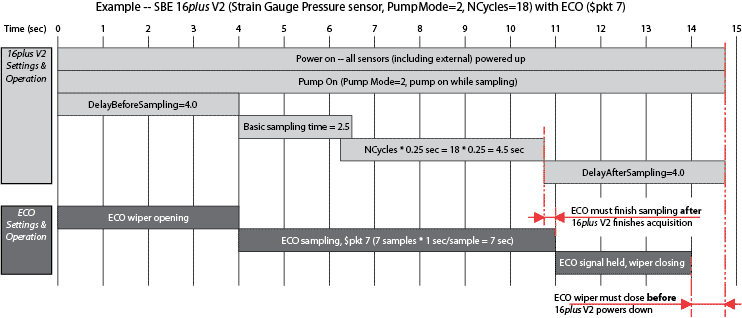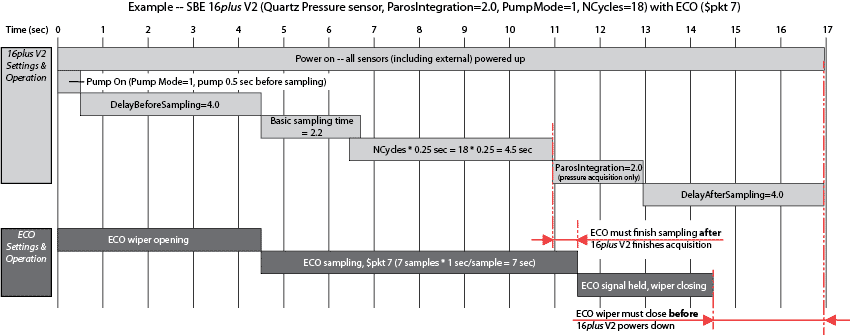APPLICATION NOTE NO. 72-V2
Setting Up WET Labs ECO Sensor with Bio-Wiper™
for integration with SeaCATplus V2 CTDs (SBE 16plus V2, 16plus-IM
V2, 19plus
V2)
April 2014
![]()
Notes:
- See Application Note 72 for integration with older
SeaCATplus (16plus, 16plus-IM, 19plus).
- DelayAfterSampling= command was implemented in SBE 16plus V2 firmware
2.5; we recommend that you update your firmware if using the CTD with a WET Labs
ECO sensor.
- DelayAfterSampling= command was implemented in SBE 19plus V2 firmware
2.5; we recommend that you update your firmware if using the CTD in moored mode
with a WET Labs ECO sensor.
- #iiDelayAfterSampling= command was implemented in SBE
16plus-IM V2 firmware 2.5.2; we recommend that you update your firmware if using
the CTD with a WET Labs ECO sensor.
This application note applies to the following models of the WET Labs ECO sensor with Bio-Wiper:
The ECO sensor can be configured to operate in Profiling or Moored mode:
When Sea-Bird integrates the ECO with one of our CTDs, we set up the ECO to operate in the mode appropriate for the CTD. However, you may want to change the mode in the future, if:
WET Labs ECO Setup
Sea-Bird SeaCATplus V2 Setup
Note: Use the #ii prefix (ii = instrument ID) when sending commands to the SBE 16plus-IM V2 (for example, #01BioWiper=Y sends BioWiper=Y to the 16plus-IM V2 with ID=01).
Connect the ECO directly to the computer and a 12 V power source, using the cable supplied by WET Labs. Configure the ECO using a terminal program or WET Labs' ECOView program.
The required comm port settings are: 19200 baud, 8 data bits, no parity.
|
Configure ECO for Profiling Mode (continuous operation) |
Configure ECO for Moored Mode (interval operation) |
| Send following commands: !!!!!! $pkt 0 $set 0 $sto |
Send following commands: !!!!!! $pkt 1 (adjust based on CTD timing and number of ECO samples desired; see Setting Up/Using CTD in Moored Mode below) $set 1 $int hhmmss (recommended value >> SeaCATplus V2 total on-time/sample. For example, send $int000500 for a 5-minute delay between sets.) $sto |
|
Notes:
|
|
After you configure the ECO for your CTD, reconnect the ECO to the CTD.
Note: Use the #ii prefix (ii = instrument ID) when sending commands to the SBE 16plus-IM V2 (for example, #01BioWiper=Y sends BioWiper=Y to the 16plus-IM V2 with ID=01).
Moored Mode Setup -- General
Enabling the Bio-Wiper command ensures that the Bio-Wiper automatically closes after sending a status command:
| Command | Description |
| Biowiper=x | x=Y: Configuration includes WET Labs
sensor with Bio-Wiper.
CTD is powered longer (a total of 8 sec) for status command (DS or
GetSD), providing 4
sec for Bio-Wiper to open and then shut again if in Moored mode. Note: 4 sec for the Bio-Wiper to open and shut is sufficient for the typical application, with the ECO set up to take a single measurement for each sample. However, the ECO can be user-programmed to take and average a number of measurements for each sample; if averaging multiple measurements, 4 sec may not provide sufficient time for the Bio-Wiper to close. For those applications, use the TV, TVR, or TS command after the status command, and then wait at least 10 sec to cycle the Bio-Wiper open/close; verify that the Bio-Wiper has closed before deploying. x=N (default): Configuration does not include WET Labs sensor with Bio-Wiper. |
Delay before sampling (DelayBeforeSampling=) sets the amount of time to wait after switching on external voltages before sampling. The ECO requires approximately 2 to 4 sec to provide time for the sensor to open the Bio-Wiper before sampling (sensor dependent; see WET Labs documentation). Set delay before sampling as follows:
Delay after sampling (DelayAfterSampling=) sets the amount of time to wait after sampling is completed, before turning off power to external sensors. The ECO requires approximately 2 to 4 sec to provide time to shut the Bio-Wiper after sampling is complete. Therefore, set DelayAfterSampling=4.
Moored Mode Setup when Multiple ECO samples are Desired ($pkt > 1)
As described above, $pkt is the number of samples sent by the ECO per interval cycle (set). The ECO provides a sample at 1 Hz (1 sample /sec), and then holds the final output voltage until power is removed. The SeaCATplus V2 averages all of the ECO data received during its own sampling cycle. Consequently, if the SeaCATplus V2 is still sampling when the ECO has finished, the final ECO voltage (which is held until power is removed) will bias the average toward the value of the last ECO sample. Therefore, if $pkt > 1, a careful timing analysis is required to ensure that the ECO sampling length extends beyond the end of the SeaCATplus V2 acquisition. This can be accomplished by modifying NCycles= (number of A/D/ acquisition cycles, each at 0.25 sec) in the SeaCATplus V2.
Two examples are shown below:
The examples assume that the ECO wiper takes 4 sec to open or close. If estimating shorter open/close time, increase the number of ECO samples accordingly. For example, use the setting $pkt 9 for a 2-sec wiper open/close time. For most ECOs, the wiper typically takes 2 sec to open/close in the air and at the ocean surface. The wiper motion cycle time can also be impacted by pressure at depth. If desired, determine the best $pkt value for your application. Provide a margin of safety for the wiper to close completely prior to powering down the SeaCATplus V2 between samples (DelayAfterSampling ≥ 4 sec).


| Date | Description |
| May 2013 | - Initial release of application note specific to V2 SeaCatplus, incorporating information on sample timing and DelayAfterSampling= command; see Application Note 72 for earlier versions of SeaCATplus. |
| April 2014 |
- Update for 16plus-IM V2 firmware 2.5.2 that
incorporated #iiDelayAfterSampling= command. - Update settings recommendations. |
![]()
Sea-Bird Home Phone: (+1) 425-643-9866 E-mail: seabird@seabird.com